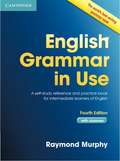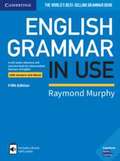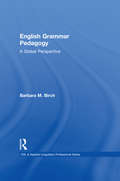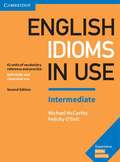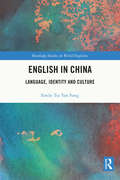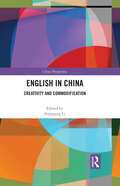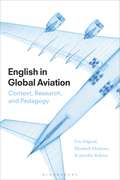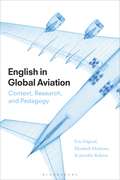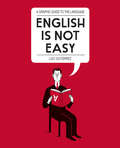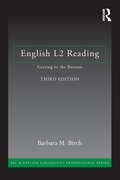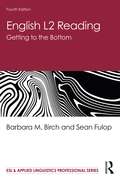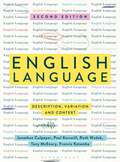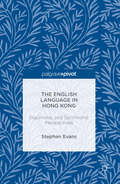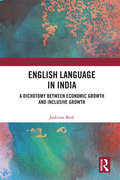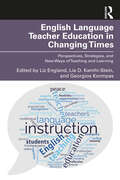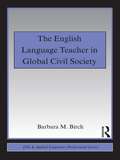- Table View
- List View
English Grammar in Use Book with Answers: A Self-Study Reference and Practice Book for Intermediate Learners of English (PDF)
by Raymond MurphyEnglish Grammar in Use Fourth edition is an updated version of the world's best-selling grammar title. It has a fresh, appealing new design and clear layout, with revised and updated examples, but retains all the key features of clarity and accessibility that have made the book popular with millions of learners and teachers around the world. This 'with answers' version is ideal for self-study. An online version, book without answers, and book with answers and CD-ROM are available separately.
English Grammar in use Book with Answers: A Self-study Reference and Practice Book for Intermediate Learners of English (Fifth Edition) (PDF)
by Raymond MurphyRaymond Murphy's English Grammar in Use is the first choice for intermediate (B1-B2) learners and covers all the grammar you will need at this level. This book has clear explanations and practice exercises that have helped millions of people around the world improve their English. It also includes an interactive ebook with audio that you can use online or download to your iPad or Android tablet. It is perfect for self-study and can also be used by teachers as a supplementary book in classrooms.
English Grammar Pedagogy: A Global Perspective
by Barbara M. BirchDesigned for ESL and ELT pedagogy courses around the world, this text describes English grammar from a World Englishes perspective. It is distinguished by its focus on the social setting for English as a global language, the latest thinking about grammatical theory, and new theories of how first and second languages are learned and taught. The fundamental premise is that teaching and learning grammar cannot be isolated from the local, regional, and global sociocultural contexts in which the teaching and learning take place. Part I presents different attitudes toward English as a global language and some challenges that learners of English share no matter where they are in the world. Part II is about the features of English that educated speakers consider the most likely and probable in Academic English. Part III describes the flexible and fluid features of English that might be susceptible to change or modification over time. Each chapter includes engaging Study, Discussion, and Essay Questions and Activities.
English Grammar Pedagogy: A Global Perspective
by Barbara M. BirchDesigned for ESL and ELT pedagogy courses around the world, this text describes English grammar from a World Englishes perspective. It is distinguished by its focus on the social setting for English as a global language, the latest thinking about grammatical theory, and new theories of how first and second languages are learned and taught. The fundamental premise is that teaching and learning grammar cannot be isolated from the local, regional, and global sociocultural contexts in which the teaching and learning take place. Part I presents different attitudes toward English as a global language and some challenges that learners of English share no matter where they are in the world. Part II is about the features of English that educated speakers consider the most likely and probable in Academic English. Part III describes the flexible and fluid features of English that might be susceptible to change or modification over time. Each chapter includes engaging Study, Discussion, and Essay Questions and Activities.
English Idioms In Use (PDF): Vocabulary Reference And Practice With Answers, Intermediate Level:vocabulary Reference And Practice With Answers, Intermediate Level
by Michael McCarthyImprove your understanding of idioms in English. Explanations and practice of English idioms, written for intermediate-level (B1 to B2) learners of English. Perfect for both self-study and classroom activities. Learn idioms in context, with lots of different topics, including 'Clothes', 'Music and theatre' and 'Work'. Be confident about what you are learning, thanks to Cambridge research into how English is really spoken and written, and get better at studying by yourself, with study tips, follow-up tasks and an easy to use answer key.
English in China: Language, Identity and Culture (Routledge Studies in World Englishes)
by Emily Tsz FongThis volume explores Chinese identity through the lens of both the Chinese and English languages. Until the twentieth century, English was a language associated with capitalists and "military aggressors" in China. However, the massive progression of globalisation in China following the 1980s has transformed the language into an important tool for China’s modernisation. Regardless of the role English plays in China, there has always been a fear there that the spread of culture(s) associated with English would lead to weakening of the Chinese identity. This fear resulted in the development of the ti-yong principle: "Chinese learning for essence (ti), Western learning for utility (yong)." Fong’s book aims to enhance understanding of the ti-yong dichotomy in relation to people’s sense of being Chinese in China, the penetration of English into non-English speaking societies, the resultant tensions in people’s sense of personal and national identity, and their place in the world. Using Q methodology, the book presents observations based on data collected from four participant groups, namely high school and university students, teachers and parents in China, to investigate their perspectives on the status and roles of English, as well as those of Chinese. Considering the growing international interest in China, this volume will appeal to readers interested in China’s contemporary society in general, its language, culture and identity. It will be a useful resource for academics, researchers and students in the field of applied linguistics, language education and Chinese cultural studies and can also be adopted as a reference book for undergraduate courses relating to language, identity and culture.
English in China: Language, Identity and Culture (Routledge Studies in World Englishes)
by Emily Tsz FongThis volume explores Chinese identity through the lens of both the Chinese and English languages. Until the twentieth century, English was a language associated with capitalists and "military aggressors" in China. However, the massive progression of globalisation in China following the 1980s has transformed the language into an important tool for China’s modernisation. Regardless of the role English plays in China, there has always been a fear there that the spread of culture(s) associated with English would lead to weakening of the Chinese identity. This fear resulted in the development of the ti-yong principle: "Chinese learning for essence (ti), Western learning for utility (yong)." Fong’s book aims to enhance understanding of the ti-yong dichotomy in relation to people’s sense of being Chinese in China, the penetration of English into non-English speaking societies, the resultant tensions in people’s sense of personal and national identity, and their place in the world. Using Q methodology, the book presents observations based on data collected from four participant groups, namely high school and university students, teachers and parents in China, to investigate their perspectives on the status and roles of English, as well as those of Chinese. Considering the growing international interest in China, this volume will appeal to readers interested in China’s contemporary society in general, its language, culture and identity. It will be a useful resource for academics, researchers and students in the field of applied linguistics, language education and Chinese cultural studies and can also be adopted as a reference book for undergraduate courses relating to language, identity and culture.
English in China: Creativity and Commodification (China Perspectives)
by Songqing LiEnglish-related linguistic creativity and language commodification are a constant topic of interest and analysis for scholars. This volume is intended to initiate a dialogue between these two domains of inquiry that have been abundantly addressed but rarely documented together or in relation to one another. English as used in mainland China is presented as a case study where it remains rather unclear the extent to which the language is actually used in people’s lives, outside the domain of education. The volume enriches existing empirical studies by exploring the creative and innovative uses of English in people’s lives and its commodification at different language-centred economic spaces within China while also providing an update of our understanding of the sociolinguistic situation of English in China, a country undergoing rapid socio-economic transformation. English in China is the first attempt to discuss the possible relationship, intersection, and tension between two seemingly inseparable research topics. The book is an important resource for students and scholars in the fields of Applied Linguistics, Bilingualism, Sociolinguistics, Translation, and Contemporary Chinese Studies.
English in China: Creativity and Commodification (China Perspectives)
by Songqing LiEnglish-related linguistic creativity and language commodification are a constant topic of interest and analysis for scholars. This volume is intended to initiate a dialogue between these two domains of inquiry that have been abundantly addressed but rarely documented together or in relation to one another. English as used in mainland China is presented as a case study where it remains rather unclear the extent to which the language is actually used in people’s lives, outside the domain of education. The volume enriches existing empirical studies by exploring the creative and innovative uses of English in people’s lives and its commodification at different language-centred economic spaces within China while also providing an update of our understanding of the sociolinguistic situation of English in China, a country undergoing rapid socio-economic transformation. English in China is the first attempt to discuss the possible relationship, intersection, and tension between two seemingly inseparable research topics. The book is an important resource for students and scholars in the fields of Applied Linguistics, Bilingualism, Sociolinguistics, Translation, and Contemporary Chinese Studies.
English in Global Aviation: Context, Research, and Pedagogy
by Eric Friginal Elizabeth Mathews Jennifer RobertsTaking readers step-by-step through the major issues surrounding the use of English in the global aviation industry, this book provides a clear introduction to turning research into practice in the field of English for Specific Purposes (ESP), specifically Aviation English, and a valuable case study of applied linguistics in action. With both cutting-edge research and evidence-based practice, the critical role of English in aviation is explored across a variety of contexts, including the national and global policies impacting training and language assessment for pilots, air-traffic controllers, ground staff, and students. English in Global Aviation teaches readers how to apply linguistic research to real world, practical settings. The book uses a range of corpus-based findings and related research to provide an effective analysis of the language needs of the aviation industry and an extended look at linguistic principles in action. Readers are presented with case studies, transcriptions, radiotelephony, and a clear breakdown of the common vocabulary and phrasal patterns of aviation discourse. Students and teachers of both linguistics and aviation will discover the requirements and challenges of successful intercultural communication in this industry, as well as insights into how to teach, develop, and assess aviation English language courses.
English in Global Aviation: Context, Research, and Pedagogy
by Eric Friginal Elizabeth Mathews Jennifer RobertsTaking readers step-by-step through the major issues surrounding the use of English in the global aviation industry, this book provides a clear introduction to turning research into practice in the field of English for Specific Purposes (ESP), specifically Aviation English, and a valuable case study of applied linguistics in action. With both cutting-edge research and evidence-based practice, the critical role of English in aviation is explored across a variety of contexts, including the national and global policies impacting training and language assessment for pilots, air-traffic controllers, ground staff, and students. English in Global Aviation teaches readers how to apply linguistic research to real world, practical settings. The book uses a range of corpus-based findings and related research to provide an effective analysis of the language needs of the aviation industry and an extended look at linguistic principles in action. Readers are presented with case studies, transcriptions, radiotelephony, and a clear breakdown of the common vocabulary and phrasal patterns of aviation discourse. Students and teachers of both linguistics and aviation will discover the requirements and challenges of successful intercultural communication in this industry, as well as insights into how to teach, develop, and assess aviation English language courses.
English is Not Easy: A Guide to the Language
by Luci GutierrezA quirkily illustrated, brilliantly risqué, but thoroughly practical, guide to the peculiarities of one of the trickiest languages on earth, for (strictly adult) students of English as a foreign language and native speakers alikeDo you know when to use whether opposed to if? For exampIe, I wonder whether I should have added a little more poison to his tea? Or where to place the comma in a conditional sentence? English is Not Easy presents the intricacies of the English language in a whimsically illustrated guide that is appealing even to the grammar averse.If all other language and grammar guides leave you snoring, look no further. English Is Not Easy doesn’t offer run-of-the-mill phrases about extreme sports and atmospheric conditions that you’ll learn in a generic English textbook. This book offers vocabulary for situations the reader will actually find themselves in. Need an insult? Those are here, too, and imbecile is the kindest of the bunch.From ‘to be’ to complicated verb tenses and seemingly nonsensical idioms, Luci’s characters, cheeky dialogue, and playful sentences bring the vocabulary, grammar and usage to life. For those who haven’t brushed up on grammar since primary school or non-native English speakers looking to improve conversation, English Is Not Easy is a fresh and infectious guide to revisiting the rules with striking illustrative adventure along the way.
English L2 Reading: Getting to the Bottom
by Barbara M. BirchEnglish L2 Reading, Third Edition offers teachers research-based insights into bottom-up skills in reading English as a second language and a solid foundation on which to build reading instruction. Core linguistic and psycholinguistic concepts are presented within the context of their application to teaching. The goal is to balance or supplement (not replace) top-down approaches and methodologies with effective low-level options for teaching English reading. The text’s pedagogical features— Questions, Study Guide Questions. Discussion Questions, Spotlight on Teaching sections— engage readers of the text in moving easily from linguistic details and psycholinguistic data and theory to practical explanations and suggestions for teaching. Two Appendices provide tables that list the graphemes or the phonemes of English. Changes in the Third Edition Shift in focus from criticism of whole language methodologies to a more neutral stance —times have changed and the study of lower-level reading strategies is now mainstream Greater focus on linguistic form, along with function and meaning Updated information about reading strategies at each level of the reading process More Spotlight on Teaching sections, one for each chapter New chapter on spelling development
English L2 Reading: Getting to the Bottom
by Barbara M. BirchEnglish L2 Reading, Third Edition offers teachers research-based insights into bottom-up skills in reading English as a second language and a solid foundation on which to build reading instruction. Core linguistic and psycholinguistic concepts are presented within the context of their application to teaching. The goal is to balance or supplement (not replace) top-down approaches and methodologies with effective low-level options for teaching English reading. The text’s pedagogical features— Questions, Study Guide Questions. Discussion Questions, Spotlight on Teaching sections— engage readers of the text in moving easily from linguistic details and psycholinguistic data and theory to practical explanations and suggestions for teaching. Two Appendices provide tables that list the graphemes or the phonemes of English. Changes in the Third Edition Shift in focus from criticism of whole language methodologies to a more neutral stance —times have changed and the study of lower-level reading strategies is now mainstream Greater focus on linguistic form, along with function and meaning Updated information about reading strategies at each level of the reading process More Spotlight on Teaching sections, one for each chapter New chapter on spelling development
English L2 Reading: Getting to the Bottom (ESL & Applied Linguistics Professional Series)
by Barbara M. Birch Sean FulopEnglish L2 Reading: Getting to the Bottom uses research-based insights to examine bottom-up skills in reading English as a second language. This fourth edition clearly presents core concepts alongside their practical applications to teaching contexts, with updated research findings, a new focus on metalinguistic awareness, and new resources for students. The text’s pedagogical features help readers connect linguistic details and psycholinguistic theory with practical explanations and teaching suggestions. Pre-reading Questions challenge readers to analyze their own experiences. Study Guide Questions allow readers to review, discuss, and assess their knowledge. Discussion Questions elaborate on themes in each chapter, while the new Language Awareness Activities help develop metalinguistic awareness. Three Appendices provide tables that list the graphemes and the phonemes of English, as well as a brand-new dictionary pronunciation guide. New to the fourth edition: Substantially revised and updated research on linguistics New, evidence-based models on the reading process Language Awareness Activities that highlight metalinguistic awareness Word study examples in each chapter For teachers, teacher trainers, reading researchers, or anyone interested in teaching reading, this popular, comprehensive, myth-debunking text provides clear and practical guidance towards effectively supplementing top-down teaching approaches with bottom-up reading strategies.
English L2 Reading: Getting to the Bottom (ESL & Applied Linguistics Professional Series)
by Barbara M. Birch Sean FulopEnglish L2 Reading: Getting to the Bottom uses research-based insights to examine bottom-up skills in reading English as a second language. This fourth edition clearly presents core concepts alongside their practical applications to teaching contexts, with updated research findings, a new focus on metalinguistic awareness, and new resources for students. The text’s pedagogical features help readers connect linguistic details and psycholinguistic theory with practical explanations and teaching suggestions. Pre-reading Questions challenge readers to analyze their own experiences. Study Guide Questions allow readers to review, discuss, and assess their knowledge. Discussion Questions elaborate on themes in each chapter, while the new Language Awareness Activities help develop metalinguistic awareness. Three Appendices provide tables that list the graphemes and the phonemes of English, as well as a brand-new dictionary pronunciation guide. New to the fourth edition: Substantially revised and updated research on linguistics New, evidence-based models on the reading process Language Awareness Activities that highlight metalinguistic awareness Word study examples in each chapter For teachers, teacher trainers, reading researchers, or anyone interested in teaching reading, this popular, comprehensive, myth-debunking text provides clear and practical guidance towards effectively supplementing top-down teaching approaches with bottom-up reading strategies.
English Language: Description, Variation and Context (PDF)
by Jonathan Culpeper Ruth Wodak Francis Katamba Paul Kerswill Anthony McEneryThe second edition of this hugely successful textbook provides comprehensive coverage of a wide range of topics in theoretical and applied linguistics. Written by leading academics in the field, this text offers a firm grounding in linguistics and includes engaging insights into current research. It covers all the key areas of linguistic analysis, including phonetics, morphology, semantics and pragmatics, and core domains of study, comprising the history of the English language, regional and social variation, style and communication and interaction. Fresh material on research methods outlines key areas for consideration when carrying out a research project, and provides students with the framework they need to investigate linguistic phenomena for themselves. This is an invaluable resource for both undergraduate and postgraduate students on English Language and Linguistics degree programmes.
English Language: Description, Variation and Context
by Jonathan Culpeper, Paul Kerswill, Ruth Wodak, Tony McEnery and Francis KatambaThe second edition of this hugely successful textbook provides comprehensive coverage of a wide range of topics in theoretical and applied linguistics. Written by leading academics in the field, this text offers a firm grounding in linguistics and includes engaging insights into current research. It covers all the key areas of linguistic analysis, including phonetics, morphology, semantics and pragmatics, and core domains of study, comprising the history of the English language, regional and social variation, style and communication and interaction. Fresh material on research methods outlines key areas for consideration when carrying out a research project, and provides students with the framework they need to investigate linguistic phenomena for themselves.This is an invaluable resource for both undergraduate and postgraduate students on English language and linguistics degree programmes. New to this Edition:- Seven new chapters covering topics such as second language acquisition, corpus linguistics and research methods- A number of chapters have been substantially revised, including those on World Englishes, Literacies in Cyberspace and TEFL, TESOL and Linguistics- Fully updated throughout to reflect the latest advances in the field
The English Language in Hong Kong: Diachronic and Synchronic Perspectives
by Stephen EvansThis book presents an empirically-grounded sociolinguistic history of the English language in Hong Kong in the past 170 years. Using substantial sets of diachronic and synchronic data, it traces the changing status and functions of English in relation to spoken Cantonese, Mandarin and written Chinese in the key domains of government, education and business. The author tracks the rise of English-knowing bilingualism in the city’s Chinese community and explores the evolutionary dynamics of Hong Kong English. He also speculates on the future of English in the territory, particularly after 2047 when the ‘one country, two systems’ framework established by the Sino-British Joint Declaration is dismantled. Researchers and students working in the fields of sociolinguistics, English as a global language, world Englishes, applied linguistics and English-language education will find this book provides valuable information and insights about the uses and users of English in colonial and post-colonial Hong Kong. More generally, it makes a unique contribution to the literature on the diffusion and diversification of English worldwide.
English Language in India: A Dichotomy between Economic Growth and Inclusive Growth
by Jaskiran BediThis book examines the relationship between the English language and growth – economic and inclusive – in India. It explores why English continues to be the language of aspiration long after Independence. With the second largest English-speaking population in the world today, India is testimonial to how a linguistic legacy continues to cast a long shadow on its contemporary discourse in the economic arena. The volume: Explores how English language proficiency constitutes as human capital. Draws in the latest India Human Development Survey data. Investigates the relationship between the language and economic indicators such as wages, household income and state growth. Purther investigates the role of English language in the inclusivity of growth. Provides a snapshot of the pedagogy of English in the Indian education system. First of its kind in scope, this volume will be of great interest to scholars of economics, education, sociolinguistics, development studies, politics and sociology. It will also be of great interest to the general reader.
English Language in India: A Dichotomy between Economic Growth and Inclusive Growth
by Jaskiran BediThis book examines the relationship between the English language and growth – economic and inclusive – in India. It explores why English continues to be the language of aspiration long after Independence. With the second largest English-speaking population in the world today, India is testimonial to how a linguistic legacy continues to cast a long shadow on its contemporary discourse in the economic arena. The volume: Explores how English language proficiency constitutes as human capital. Draws in the latest India Human Development Survey data. Investigates the relationship between the language and economic indicators such as wages, household income and state growth. Purther investigates the role of English language in the inclusivity of growth. Provides a snapshot of the pedagogy of English in the Indian education system. First of its kind in scope, this volume will be of great interest to scholars of economics, education, sociolinguistics, development studies, politics and sociology. It will also be of great interest to the general reader.
English Language Teacher Education in Changing Times: Perspectives, Strategies, and New Ways of Teaching and Learning
by Liz England Lía D. Kamhi-Stein Georgios KormpasThis volume addresses challenges that the field of English language teacher education has faced in the past several years. The global pandemic has caused extreme stress and has also served as a catalyst for new ways of teaching, learning, and leading. Educators have relied on their creativity and resiliency to identify new and innovative teaching practices and insights that inform the profession going forward. Contributors describe how teacher educators have responded to the specific needs and difficulties of educating teachers and teaching second language learners in challenging circumstances around the world and how these innovations can transform education going forward into the future. Paving the way for a revitalized profession, this book is essential reading for the current and future generations of TESOL scholars, graduate students, and professors.
English Language Teacher Education in Changing Times: Perspectives, Strategies, and New Ways of Teaching and Learning
This volume addresses challenges that the field of English language teacher education has faced in the past several years. The global pandemic has caused extreme stress and has also served as a catalyst for new ways of teaching, learning, and leading. Educators have relied on their creativity and resiliency to identify new and innovative teaching practices and insights that inform the profession going forward. Contributors describe how teacher educators have responded to the specific needs and difficulties of educating teachers and teaching second language learners in challenging circumstances around the world and how these innovations can transform education going forward into the future. Paving the way for a revitalized profession, this book is essential reading for the current and future generations of TESOL scholars, graduate students, and professors.
The English Language Teacher in Global Civil Society (ESL & Applied Linguistics Professional Series)
by Barbara M. BirchHow can English language teachers contribute to peace locally and globally? English language teachers and learners are located in the global civil society – an international network of civil organizations and NGOs related to human rights, the environment, and sustainable peace. English, with its special role as an international language, is a major tool for communication within this network. On the local level, many teachers are interested in promoting reconciliation and sustainable peace, but often do not know how to do so. This book provides information, analysis, and techniques to help teachers around the world take action toward this goal. Balancing, in a readable and accessible way, the global and the local, core and periphery, cultural diffusion and resistance, theory and practice, pessimism and optimism, outsider and insider perspectives, the expert role and the apprentice role, and prescriptive and elicitive methods, it offers an alternative to literature about critical applied linguistics, globalization, and peace education that is simply too complex and wordy to spread easily from theoretician to the classroom teacher. The English Teacher in Global Civil Society: synthesizes threads from many fields and topics into a coherent and empowering argument for the activist role English language teachers can take to promote social change draws on humanistic education, peace education, cross-cultural understanding, problem-posing, cooperative learning, and critical thinking methodologies to help English language teachers learn how to teach conflict resolution skills in their classrooms covers issues in critical applied linguistics, approaches and methodologies in ESL/EFL, global and local curricular issues, and specific skill areas such reading, writing, and speaking suggests a new goal for English language teachers: global citizenship. This engaging, informative, provocative, and highly readable book is a welcome resource for English language teacher trainers, pre-service teachers, practicing classroom teachers, and Peace Corps workers around the world.
The English Language Teacher in Global Civil Society (ESL & Applied Linguistics Professional Series)
by Barbara M. BirchHow can English language teachers contribute to peace locally and globally? English language teachers and learners are located in the global civil society – an international network of civil organizations and NGOs related to human rights, the environment, and sustainable peace. English, with its special role as an international language, is a major tool for communication within this network. On the local level, many teachers are interested in promoting reconciliation and sustainable peace, but often do not know how to do so. This book provides information, analysis, and techniques to help teachers around the world take action toward this goal. Balancing, in a readable and accessible way, the global and the local, core and periphery, cultural diffusion and resistance, theory and practice, pessimism and optimism, outsider and insider perspectives, the expert role and the apprentice role, and prescriptive and elicitive methods, it offers an alternative to literature about critical applied linguistics, globalization, and peace education that is simply too complex and wordy to spread easily from theoretician to the classroom teacher. The English Teacher in Global Civil Society: synthesizes threads from many fields and topics into a coherent and empowering argument for the activist role English language teachers can take to promote social change draws on humanistic education, peace education, cross-cultural understanding, problem-posing, cooperative learning, and critical thinking methodologies to help English language teachers learn how to teach conflict resolution skills in their classrooms covers issues in critical applied linguistics, approaches and methodologies in ESL/EFL, global and local curricular issues, and specific skill areas such reading, writing, and speaking suggests a new goal for English language teachers: global citizenship. This engaging, informative, provocative, and highly readable book is a welcome resource for English language teacher trainers, pre-service teachers, practicing classroom teachers, and Peace Corps workers around the world.
